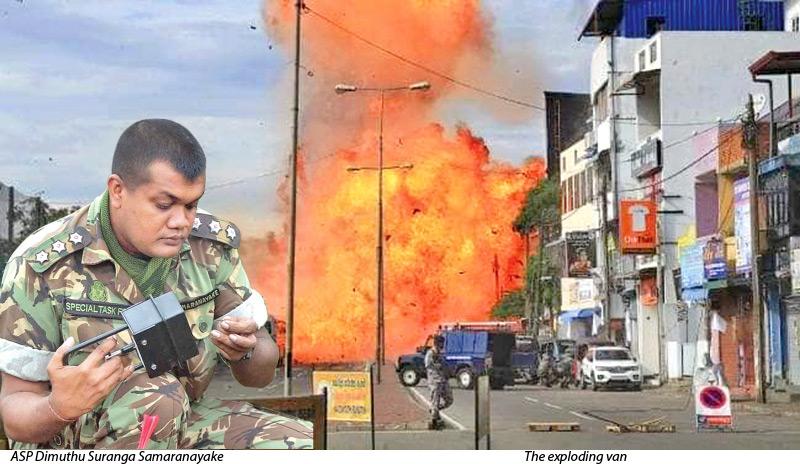
It was another laid back Easter Sunday holiday in Sri Lanka last year when the country was rocked by a series of explosions targeting churches and hotels around the country. The devastating suicide attacks by a group of homegrown terrorists left over 250 people dead and over 500 people with life-changing injuries.
 The proceedings of the Presidential Commission of Inquiry (PCoL) on the Easter Sunday attacks, last week, revealed that casualties would have been higher had a second bomb set up in a van outside St. Anthony’s Church, Kochchikade detonated, as planned by the terrorists. It was luck and the bravery of one Special Task Force (STF) officer that had prevented further loss of life.
The proceedings of the Presidential Commission of Inquiry (PCoL) on the Easter Sunday attacks, last week, revealed that casualties would have been higher had a second bomb set up in a van outside St. Anthony’s Church, Kochchikade detonated, as planned by the terrorists. It was luck and the bravery of one Special Task Force (STF) officer that had prevented further loss of life.
Giving evidence before the Commission last week, Director of the STF Terrorism Prevention and Bomb Disposal Unit, ASP Dimuthu Suranga Samaranayake said if the second bomb in the vicinity of St. Anthony’s Church had exploded, the loss of life that could have occurred was unfathomable. “If the bomb exploded as planned perhaps 2,000-3,000 lives may have been lost,” he said.
According to ASP Samaranayake, investigations had revealed that the explosive device inside the van had been set up targeting the gathering at the scene following the first explosion inside the church.
According to a previous testimony of the Parish Priest of St. Anthony’s Church, Fr. Jude Raj Fernando, he had questioned authorities as to why vehicles around the church had not been moved even by afternoon on the day of the attack. A policeman in response had said, “Father don’t worry, everything is clear”. However, the van carrying a second bomb had remained undetected even as dignitaries and the public visited the site of the attack. It was the CCTV footage of a nearby house that eventually revealed the danger lying in wait.
Samaranayake during his testimony on Wednesday also said the second bomb inside the van had been set up only after the vehicle was brought to the scene of the attack on Easter Sunday. According to him, the CCTV footage also revealed that the second bomb was set up by the same suicide bomber who targeted St. Anthony’s Church and it had taken him a mere 28 minutes.
Samaranayake said the technique used showed that it could not have been set up elsewhere and brought to the location.
Samaranayake said that he was not able to deactivate the bomb. “It had already been activated when I approached to deactivate it,” he told the Commission.
According to Samaranayake, he had received information about the second bomb around 1.45 pm on April 22, the day after the initial attacks. “I sent the OIC of the Bomb Disposal Unit, IP Priyantha, a trained expert in explosives, to the site. I sent him there as he was already involved in investigations close to the site,” he said.
Calling his superior around 2.15 p.m., IP Priyantha had informed Samaranayake that the bomb had a complex circuit. “I understood then the situation was dangerous,” he said.
A veteran in the field who was instrumental in preventing a number of explosions during the country’s war against terrorism, Samaranayake had decided to go to the scene himself. He had sped to the site on a motorcycle. “The public had already been evacuated and the site secured by the time I got there,” he said.
Arriving on the scene, he had approached the van to inspect the explosive device sans any personal protection equipment. “Others around me called out saying ‘Sir, do not go there’, I only realised the danger of the situation much later,” he said.
On observation, it was revealed that the bomb was set up through three complicated techniques using four gas cylinders. The timer had been set to a maximum of one hour and while the time had lapsed, it had not exploded as the electricity supplied to the circuit had faltered. “I realised a wire had to be pulled for the bomb to detonate,” he said, adding that he thereafter planned to do so using equipment used for controlled detonations.
But according to Samaranayake, his attempt had led to the wire being pulled further than expected leading to the immediate explosion of the bomb. A utility pole on the street had saved his life. “I knew it was about to explode and moved away from the van,” he said, adding he was shielded by the pole as the explosion happened. “I only survived through luck. At that moment I saw my life flash before my eyes,” he said.
Even as a dog in the vicinity was blown into pieces, Samaranayake said he felt the shock of the explosion. “I was shocked and wondered why nothing had happened to me. I had been taking cover behind a utility pole. It had taken the brunt of the explosion and saved my life,” he said.
According to Samaranayake as the bomb was activated had the van been moved to a different location or even any slight movement would have led to the bomb exploding.
During the testimony, it was also revealed that the bomb had been made at the house rented by terror mastermind Zahran Hashim, and the gas cylinders had been bought for Rs. 35,000 the day before. Hashim had drawn the method to set up the bomb on a paper and handed it over to the other attacker.
